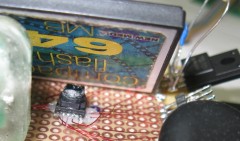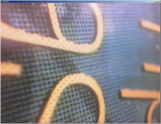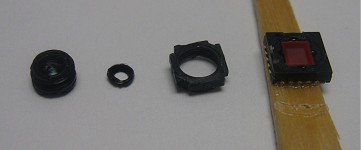- Fri Jul 31, 2009 11:46 pm
#78062
@lastid: I've also just started playing with this camera (actually, the simpler TCM8230 variant) for a project where I need to sample an image at very close range (~ 1cm). Regarding the focus, I have some good news and bad news.
The bad news: The lens is on a threaded barrel for focal length adjustment, but the chips come from the factory pre-focused (probably for "infinity", though I haven't measured...think typical fixed-focus cellphone cam), and fixed in place with some kind of thread-locking adhesive.
The good news: I've worked out a pretty reliable procedure to unlock the threads and allow for adjustment. You can then adjust the focal distance for closer range (up to <1cm) by screwing the lens out (counterclockwise). Here's how to do it.
1) Find the seam where the main rectangular body (the part the lens screws into) mates with the base (the halves are held together by glue), and dab some epoxy (or other heat-safe glue) over the seam. The reason will become evident in the next steps.
2) Bake at the highest allowed storage temperature from the datasheet (60C?) for at least one hour.
3) Remove from oven and put a couple drops of isopropanol (or 91% rubbing alcohol) where the lens screws in, allowing it to flow into the threads. Let it sit for several minutes (if too much evaporates, add more). Although it does not dissolve the thread glue, the combination of heat and solvent seems to loosen its grip on the plastic considerably. Unfortunately it seems to have the same effect on the glue that holds the rest of the package together, hence the glue reinforcement earlier.
4) There is a pair of small indentations (notches/holes), one on either side of the square lens face. Clamp the part gently in a vise, and with some very needle-nosed pliers/tweezers inserted into these notches, very carefully rotate the lens counterclockwise. There may be a discernable 'snap' as the thread glue releases. Once this happens, you can unscrew the lens completely and (if desired) run an isopropanol-soaked Q-tip over the threads to dislodge any remaining glue.
I tried making a cast of the lens face and using that to rotate it, but there's very little face for it to grab onto - the tweezers worked better for me.
Some pictures of the results:

 <--- resulting image
<--- resulting image
 <---this is what can happen without reinforcing the main package glue
<---this is what can happen without reinforcing the main package glue 
The bad news: The lens is on a threaded barrel for focal length adjustment, but the chips come from the factory pre-focused (probably for "infinity", though I haven't measured...think typical fixed-focus cellphone cam), and fixed in place with some kind of thread-locking adhesive.
The good news: I've worked out a pretty reliable procedure to unlock the threads and allow for adjustment. You can then adjust the focal distance for closer range (up to <1cm) by screwing the lens out (counterclockwise). Here's how to do it.
1) Find the seam where the main rectangular body (the part the lens screws into) mates with the base (the halves are held together by glue), and dab some epoxy (or other heat-safe glue) over the seam. The reason will become evident in the next steps.
2) Bake at the highest allowed storage temperature from the datasheet (60C?) for at least one hour.
3) Remove from oven and put a couple drops of isopropanol (or 91% rubbing alcohol) where the lens screws in, allowing it to flow into the threads. Let it sit for several minutes (if too much evaporates, add more). Although it does not dissolve the thread glue, the combination of heat and solvent seems to loosen its grip on the plastic considerably. Unfortunately it seems to have the same effect on the glue that holds the rest of the package together, hence the glue reinforcement earlier.
4) There is a pair of small indentations (notches/holes), one on either side of the square lens face. Clamp the part gently in a vise, and with some very needle-nosed pliers/tweezers inserted into these notches, very carefully rotate the lens counterclockwise. There may be a discernable 'snap' as the thread glue releases. Once this happens, you can unscrew the lens completely and (if desired) run an isopropanol-soaked Q-tip over the threads to dislodge any remaining glue.
I tried making a cast of the lens face and using that to rotate it, but there's very little face for it to grab onto - the tweezers worked better for me.
Some pictures of the results:

 <--- resulting image
<--- resulting image <---this is what can happen without reinforcing the main package glue
<---this is what can happen without reinforcing the main package glue 